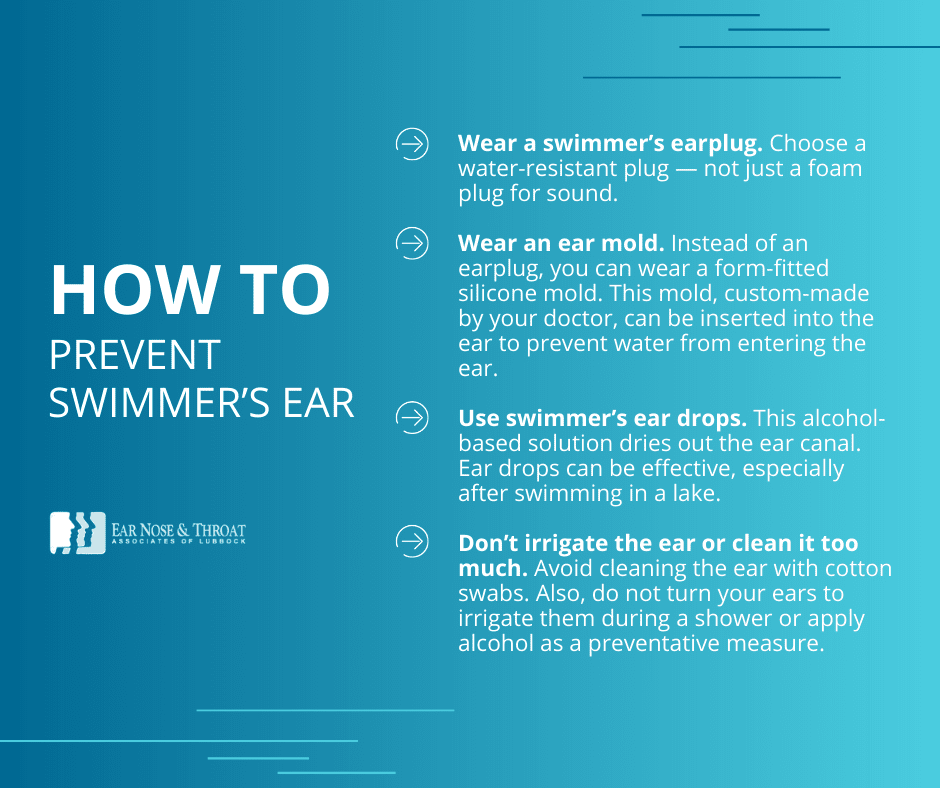Swimmer’s Ear: Causes, Symptoms & Treatment

Summer is here! While most people (especially kids) take this as an open invitation for regular pool time, some dread the inevitable swimmer’s ear that will soon follow all that time in the water.
As you prepare for your days on the lake, in the pool, or at the beach, here’s what you need to know about swimmer’s ear treatment… and prevention!
What is Swimmer’s Ear?
Swimmer’s ear, also called otitis externa, describes inflammation of the external ear. While ear infections (otitis media) take place in the middle ear, a swimmer’s ear infection affects the skin of the auditory canal and the skin on the ear itself… basically any skin outside of the eardrum.
As the name indicates, swimmer’s ear is common in swimmers. But the reason for the infection is less clear.
In the past, swimmer’s ear likely occurred because people used to swim in dirty water. Essentially, they were swimming in bacteria, which would enter the ear and cause an infection. Since the eardrum forms a barrier to the middle ear space, the bacteria didn’t move to a middle ear infection, but the external ear reacted.
Now, the problem may come from a nearly opposite reason in swimmers — the ear is too clean. Ear wax controls the pH balance of the ear canal and prevents bacteria from growing. But if the ear is completely clean and washed out from regularly swimming, the pH or biome of the ear canal may be altered, allowing for the growth of bacteria. Essentially, an ear that’s too clean might create an environment for opportunistic bacteria infections.
How To Know If You Have Swimmer’s Ear
Swimmer’s ear is extremely painful. This infection also turns the ear red and causes swelling. The ear canal may even swell to the point where it’s difficult to see into the ear. In most cases, a red painful ear, especially after time in the water, indicates swimmer’s ear.
Some people also experience drainage that oozes from the inflammation in the ear. Because of the drainage, hearing can be muffled, making it sound like you’re wearing an earplug.

Swimmer’s Ear Treatment
Swimmer’s ear is relatively easy to treat. Because it’s a skin condition and we have access to the skin that’s affected, we can treat it with drops. When you apply the right combination of antibiotic or steroid drops to the skin, the infection usually improves quickly.
In some severe cases, oral antibiotics and/or steroids are also necessary to completely eliminate the infection.
If the canal is so swollen the drops can’t enter the ear, we can insert a wick — a small, elongated piece of foam. You then apply the drops to the end that’s sticking out. The wick dissipates the drops through the canal to the areas that cannot otherwise be reached.
How to Prevent Swimmer’s Ear
Swimmer’s ear isn’t typically recurring. While some people experience it repeatedly, it’s not linked to inherent risk. Instead, repeated cases of swimmer’s ear happen because you are repeatedly exposed to the same conditions that allow bacteria to enter the ear.
If you repeatedly experience swimmer’s ear, consider these options for prevention:
1. Wear a swimmer’s earplug.
Choose a water-resistant plug — not just a foam plug for sound.
2. Wear an ear mold.
Instead of an earplug, you can wear a form-fitted silicone mold. This mold, custom-made by your doctor, can be inserted into the ear to prevent water from entering the ear. For most people, ear molds are more comfortable than earplugs.
3. Use swimmer’s ear drops.
This alcohol-based solution dries out the ear canal. Ear drops can be effective, especially after swimming in a lake.
However, don’t overdo it. Over-drying the ear isn’t healthy. Only use drops after swimming — not as a preventative measure.
If you have ear tubes, avoid ear drops or any alcohol in the ear. The alcohol will travel through the tube and cause extreme discomfort.
4. Don’t irrigate the ear or clean it too much.
Avoid cleaning the ear with cotton swabs. Also, do not turn your ears to irrigate them during a shower or apply alcohol as a preventative measure.
As a rule, the dryer the ear, the better.
Don’t let fear of swimmer’s ear keep you out of the water. With the right prevention and treatment plan, you should be set for a great time in the water that won’t leave you paying the price for days to come.
Dr. Cuthbertson is a physician at Ear Nose & Throat Associates of Lubbock. He joined the team at ENT Lubbock from Houston, where he was chief resident of the prestigious Bobby R. Alford Department of Otolaryngology at Baylor College of Medicine. He is board certified in Otolaryngology and Head & Neck Surgery and has quickly built a reputation, not only as an extremely skilled surgeon, but as an approachable and compassionate clinician adept in the newest standards and technologies. Learn more about Dr. Cuthbertson.
Categories:








